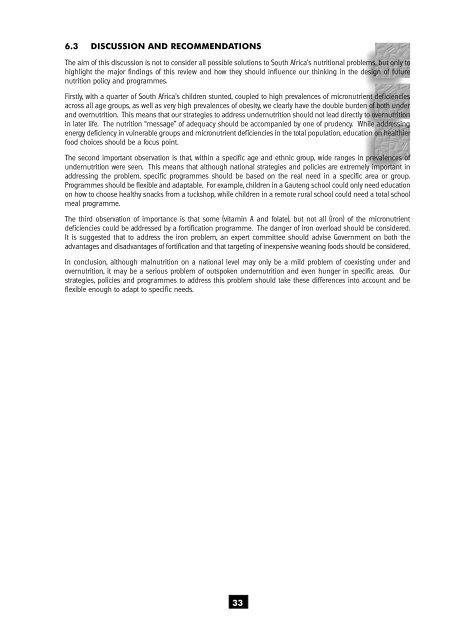the nutritional status of - Health Systems Trust
the nutritional status of - Health Systems Trust
the nutritional status of - Health Systems Trust
Create successful ePaper yourself
Turn your PDF publications into a flip-book with our unique Google optimized e-Paper software.
6.3 DISCUSSION AND RECOMMENDATIONS<br />
The aim <strong>of</strong> this discussion is not to consider all possible solutions to South Africa’s <strong>nutritional</strong> problems, but only to<br />
highlight <strong>the</strong> major findings <strong>of</strong> this review and how <strong>the</strong>y should influence our thinking in <strong>the</strong> design <strong>of</strong> future<br />
nutrition policy and programmes.<br />
Firstly, with a quarter <strong>of</strong> South Africa’s children stunted, coupled to high prevalences <strong>of</strong> micronutrient deficiencies<br />
across all age groups, as well as very high prevalences <strong>of</strong> obesity, we clearly have <strong>the</strong> double burden <strong>of</strong> both under<br />
and overnutrition. This means that our strategies to address undernutrition should not lead directly to overnutrition<br />
in later life. The nutrition “message” <strong>of</strong> adequacy should be accompanied by one <strong>of</strong> prudency. While addressing<br />
energy deficiency in vulnerable groups and micronutrient deficiencies in <strong>the</strong> total population, education on healthier<br />
food choices should be a focus point.<br />
The second important observation is that, within a specific age and ethnic group, wide ranges in prevalences <strong>of</strong><br />
undernutrition were seen. This means that although national strategies and policies are extremely important in<br />
addressing <strong>the</strong> problem, specific programmes should be based on <strong>the</strong> real need in a specific area or group.<br />
Programmes should be flexible and adaptable. For example, children in a Gauteng school could only need education<br />
on how to choose healthy snacks from a tuckshop, while children in a remote rural school could need a total school<br />
meal programme.<br />
The third observation <strong>of</strong> importance is that some (vitamin A and folate), but not all (iron) <strong>of</strong> <strong>the</strong> micronutrient<br />
deficiencies could be addressed by a fortification programme. The danger <strong>of</strong> iron overload should be considered.<br />
It is suggested that to address <strong>the</strong> iron problem, an expert committee should advise Government on both <strong>the</strong><br />
advantages and disadvantages <strong>of</strong> fortification and that targeting <strong>of</strong> inexpensive weaning foods should be considered.<br />
In conclusion, although malnutrition on a national level may only be a mild problem <strong>of</strong> coexisting under and<br />
overnutrition, it may be a serious problem <strong>of</strong> outspoken undernutrition and even hunger in specific areas. Our<br />
strategies, policies and programmes to address this problem should take <strong>the</strong>se differences into account and be<br />
flexible enough to adapt to specific needs.<br />
33
















